Olympus Q&A, CP+ 2016: Corporate recovery, IS tech, whither the AIR, and the PEN-F “experiment”
posted Saturday, March 5, 2016 at 5:16 AM EDT

Imaging Resource founder and Publisher Dave Etchells had a chance to sit down with Masamichi Handa and Toshiyuki Terada of Olympus Corporation's Imaging Business Unit (the division responsible for producing their cameras and lenses) at the recent CP+ show in Yokohama, Japan. Mr. Handa is the Executive Officer and Head of the Imaging Business Unit, while Mr. Terada is the General Manager of their Global Marketing Strategy Department. Topics of conversation included whether Olympus has fully recovered from the investment and accounting crisis of several years ago, and if so, what impact that might have on their camera and lens development going forward, the fate of the PEN line of cameras, whether Olympus will enter the large-sensor compact business or not (think in terms of competitors to Sony's RX line and Canon's G7x models), and some surprising insight on how the company views its recently-announced PEN-F mirrorless model.
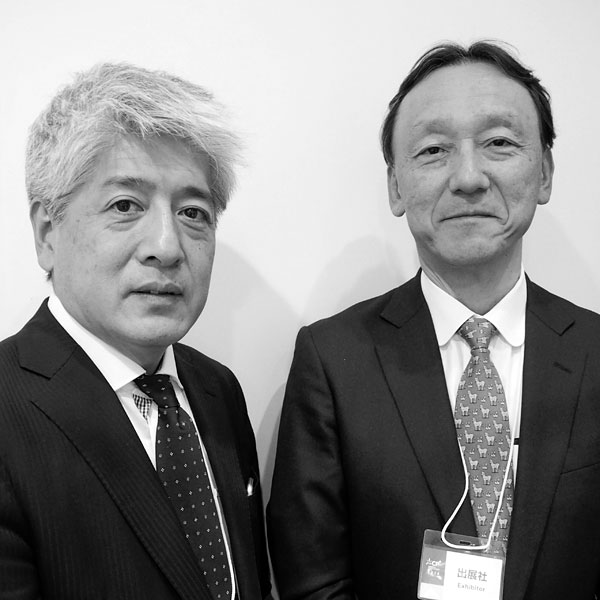
Dave Etchells/Imaging Resource: I'll start out with a question about the general health [of Olympus Corp.]. It's been many years now since the financial problems under former Chairman Kikukawa-san (former Chairman of Olympus Corporation, Tsuyoshi Kikukawa). At the time, Olympus said that it had to make some difficult changes and downsize, and that they would be all complete by I think 2014 or 2015. So now, is Olympus really, finally, completely past all of that? And did the measures you had to take impact camera and lens development? Now that that is past, are you able to put more money into research and development?
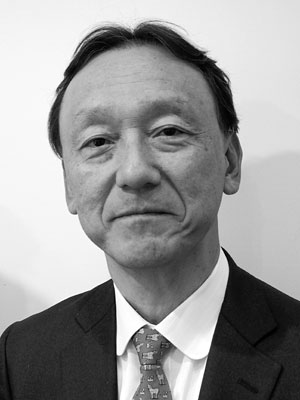
Executive Officer and Head of
Imaging Business Unit
Olympus Corp.
Masamichi Handa/Olympus: Yeah. Well, after having sort of a difficult time, as you might know, our old board members changed and new members [were appointed], coming from internally [within Olympus Corp.] as well as externally, and a new management team was set up. Then we focused on more compliance and governance, more of the need to built up the right organization, the right company at Olympus. Then we also sold the non-core business units.
DE: Many other business units, yeah.
MH: Many other new business areas, that we spent money to purchase [before the financial problems], but this didn't work well. Then we launched a recovery program, "back to basics", and we focused on three major business areas. Namely our medical business, our life science or scientific business, and our imaging business.
DE: Yes.
MH: And so we are focusing on only these three core businesses. We sold the non-core businesses. That's why our top line went down to some extent. Then starting probably from last year, we are now increasing the top line as well as bottom line -- the operating income, profit. So our company is more healthy.
[Ed. Note: "Top line" means overall business volume.]
DE: More healthy.
MH: Much more. And because of this, our share prices are going up, you know. I think [at the lowest point] the price was something like 500 yen, lowest one. But now it is around 4,000 yen...
DE: 4,000 yen, that's a factor of eight -- wow!
(Stock chart courtesy of Google Finance.)
MH: And last year, our peak was 5,000 yen because of depreciation in the yen. This is very beneficial to Olympus, as we are producing medical products in Japan. which we are selling all over the world. So that is quite beneficial if we have the yen depreciation.
DE: Right.
MH: So last year, when we [reached the] peak of the yen depreciation, our share price became higher, so that it hit 5,000 yen. Right now, it is around 4,000 or 4,200 yen.
DE: The yen is a little stronger now than it was at the weakest, yeah.
MH: Yeah. But Olympus position is becoming much better than before. That also illustrates our healthier situation, right?
DE: Yes.
MH: Then we announced our financial information for this fiscal year. The forecast this year is that the top line will become eight billion dollars.
DE: Eight billion dollars? Wow, I didn't realize the corporation was that big, overall.
MH: Eight billion dollars, and this is seven percent higher than last year. And also operating income grew to 0.9 billion dollars, thanks to the medical business growth. For our imaging company, we have been in difficult times, but our third-quarter financial result showed a profit. This is the first time in five years.
DE: Oh, really? That's very good news indeed.
[Ed. Note: This was interesting; I'd actually thought they had been profitable for a little while, given how successful the OM-D E-M5, E-M5 II and E-M1 were. Good to know that they're at least in the black now, though.]
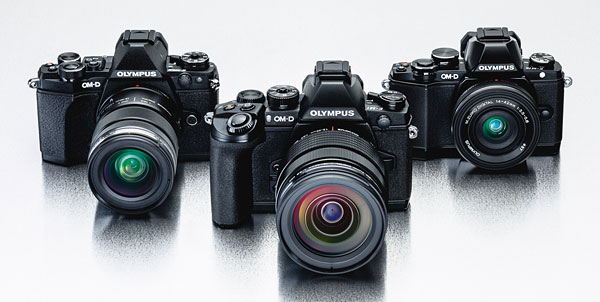
MH: So the imaging division also is becoming better. Regarding our investment, the market situation is becoming a little bit stagnant, right? And we in the imaging division have to show a profit, so we need to be careful with our spending.
DE: Yes.
MH: So [for that reason] we focus more on our OM-D category, not on the digital compact cameras. So we are now investing less and less resources on compact cameras, and more focusing on the OM-D, the interchangeable-lens mirrorless cameras.
DE: Yes. So the company is much more secure, and quite profitable. That seems pretty good, 0.9 billion net on eight billion gross is a margin of more than 10%...
MH: Yeah. And before, when we showed losses then also we announced during the company restructuring why we need to have the imaging business. It was always an ongoing topic, but once we reached the end of the discussion, the top management very much supported the imaging business.
DE: Ah, I see. So when the difficult times were there, top management were asking "Why do we need imaging?"
MH: Yes. I had many discussions with the new board. That was a very tough time. They were asking why we made a loss, and why Olympus needed the imaging business, but now they accept that its important to Olympus and now, you know...
DE: ...the company is much more behind the imaging business.
MH: They're behind the imaging business, that's right.
DE: Ah. That's all very good news for us photographers. Very good to hear! We don't track market share numbers ourselves, but our sense just from our readers and the products we see is that Olympus has been doing fairly well lately, especially with enthusiasts. How is your market share looking, and what is your strategy to increase market share?
MH: Right. Market share is very important, and if we talk about [the Japanese camera-industry body] CIPA's data, for the 2015 calendar year, the interchangeable-lens market showed negative five percent overall growth.
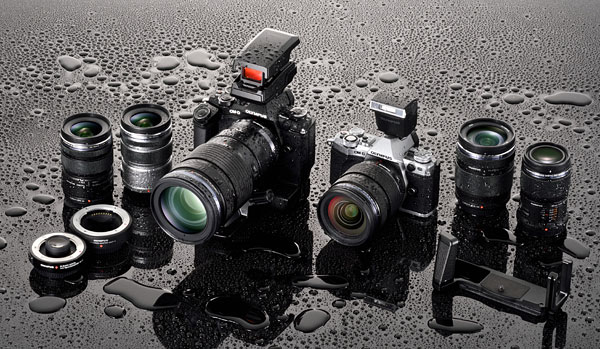
DE: Minus five percent in ILCs, right.
MH: Over the same period, Olympus showed five percent growth.
DE: Ah! So you're outperforming the market by about ten percent.
MH: Almost all regions are outperforming, compared to the general trend. Now as far as SLR or mirrorless cameras are concerned, the SLR category is showing minus eight percent. The compact system camera -- or mirrorless -- category is showing two percent better than last year. So the SLR market is going down, and mirrorless is going up.
DE: Yeah.
MH: [Speaking about] mirrorless, the value [segment] is showing nine percent up, so that trend looks quite positive.
[Ed. Note: Here, Handa-san is talking about the increase in dollar volume vs. unit sales.]
DE: Nine percent up. Ah!
MH: As far as Olympus is concerned, as far as mirrorless is concerned.
DE: Yeah. That's very good. Again, good news for Olympus fans.
MH: Yeah.
DE: It seems to me that there's been a change in Micro Four Thirds and mirrorless [in general]. Originally, it was really intended to be or viewed as being a step-up platform. The intention was that people coming from compacts, you know, point-and-shoots, would step up from their less sophisticated cameras to interchangeable-lens models. I think that actually was how it worked in Japan, that mirrorless was very much a step-up for consumers.
In the US, though, mirrorless was always an enthusiast product, or at least much more so. For Olympus, the PEN line was your series aimed more at the entry-level users. And for a while, that was a major focus, but now it seems like you are shifting more to enthusiasts, to the higher-end users. What can you say about how your product line is going to evolve going forward?
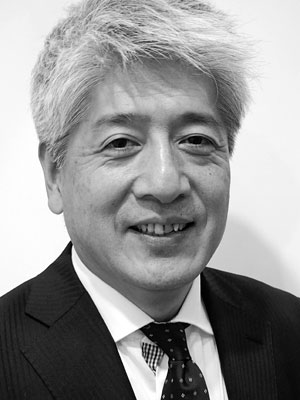
General Manager
Global Marketing Strategy Department
Imaging Business Unit
Olympus Corp.
Toshiyuki Terada/Olympus: Sure. As you know, we have two main product lines for the interchangeable-lens system. One is OM-D, the other is PEN, right? And especially with the PEN line, we are focusing on -- as you said -- the entry class or step-up [purchases] from smartphone users or compact camera users. We want to invite them to the interchangeable-lens system, because of the small compact size and ease of use, the more creative things they can do [compared to what is possible with a smartphone or compact camera].
DE: Yeah.
TT: And the reason why we are now launching the new PEN-F -- this is also categorized as a PEN-series camera, but it targets a different user, as you can see.
DE: There's a different target user, yes.
TT: Yeah, sure. This is [directed more towards] the enthusiast users, and not females. The main target is males. This is kind of our challenge, to find new customers for Olympus cameras. Basically, the PEN brand creates new [interchangeable-lens camera] users out of compact or smartphone users. But now, we are trying with the PEN-F to capture photography enthusiasts. They may like this rangefinder-style camera rather than a DSLR-style camera.
[Ed. Note: "Enthusiast users and not females" may sound sexist, but just looking at our own reader stats, it's a simple reality that enthusiast photographers tend to be a pretty male-dominated group. There are certainly plenty of female photo enthusiasts, and plenty of male camera-owners that don't fit the "enthusiast" designation, but the overall population is pretty gender-skewed.]
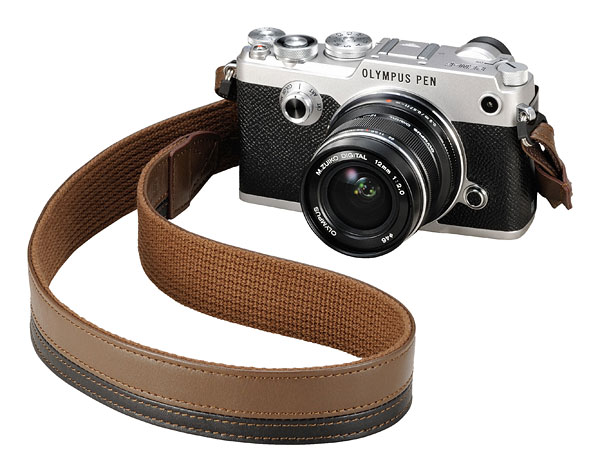
DE: Yeah. So the PEN line you've always seen as being "this is where you bring people into the Olympus mirrorless family"...
TT: Yeah. Sure, sure.
DE: ...and so now, rather than just bringing entry-level users, you're looking at the PEN-F to bring over users of other platforms into the Olympus brand.
TT: Yes, just so.
DE: So the last consumer PEN was the E-PL7, and that was launched, gosh, about one and a half years ago now. I know you can't comment on specific products...
TT: <laughter>
DE: ...so I have to think how to phrase this, but do you see there being some PEN cameras that will continue to be more consumer-oriented...
TT: Yes, of course. Sure. As I said, the PEN line is important for us from the target user point of view.
DE: Yeah.
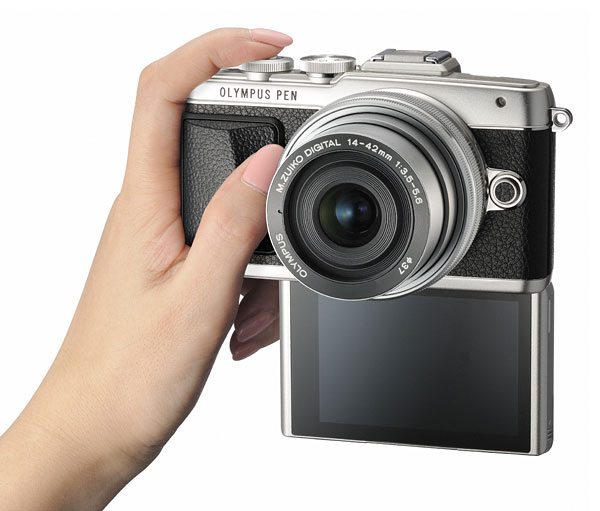
TT: And because it is important, we are supplying new cameras for the PEN line. From that point of view, the PEN-F is different to other PEN-series cameras. At this time, we have no plan to have a series like the PEN-F.
DE: Ah, so this is really a one-off camera...
TT: Just a one-off at this moment. But we are seeing the market reaction, and seeing the situation. If we can create new customers with the PEN-F, then it may become a series, or there may be the next model or something. But this is just a trial.
DE: Mmm. It's a bit of an experiment to see how the market responds.
[Ed. Note: This was extremely interesting, to have a company state so candidly that a particular product is a bit of a trial balloon. I was also somewhat surprised that Olympus views the PEN-F as a means by which to bring users of other platforms into the Olympus family. I can certainly see that, as it has a very distinct visual and user-experience appeal, but to the extent I'd thought about it, I assumed it was aimed at the high-end, or at least high-aesthetic end, of Olympus' existing users.]
TT: Sure, that's right. But on the other hand, for the PEN E-PL line, of course we have a certain lifetime for the PL7...
DE: Yeah. It's been a year and a half, so we wouldn't be surprised if we saw a PL8 at some point.
TT: Sure, that's right.
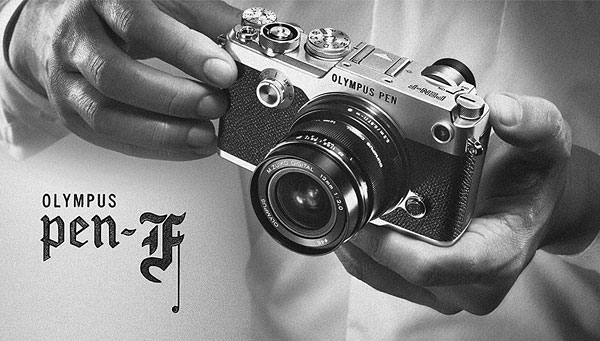
DE: Yeah, we liked the PEN-F very much. I think we at IR are maybe the kind of people that it is aimed at, you know -- it's kind of our kind of camera.
TT: <laughter> Yes, I think so. <laughter>
DE: But I mean, it's a challenge from a sales standpoing; it's a very expensive product. It's well in the upper end, in terms of cost.
TT: Yes.
DE: But, yeah, we find it very appealing. I haven't spent any time with it myself with, but my guys have been out shooting with it said "Wow, this is a lot of fun!" We especially liked the controls on the outside, and the selector dial on the front.
TT: Yes, the Creative dial. Yeah.
DE: My next question is also about your consumer profile. Back when the E-M1 was announced at PhotoPlus in New York, I interviewed Ogawa-san, and he said that the PEN line had been successful in reaching the female market. But the market has changed a lot since then; you know, the large sensor compacts have become a very significant part. I'm wondering what you know about women's purchase preferences? Does a larger camera like the PEN-series continue to be interesting to them, or do you see more of them going towards the smaller one-inch sensor cameras? How is that working in your product line now?
TT: From our point of view, if we ask smartphone users or [for that matter] females, there are two distinct groups. For one group, just the smartphone is enough. But for the other group, once they have something interesting to photograph, they like to have more capable camera.

DE: Yeah, yeah. Interesting.
TT: Then currently our solution is that the PEN line is enough to capture those customers.
DE: That's interesting. So if someone, the smartphone user -- whether male or female -- once they decide that they have an interest in photography, then they want to go all the way and buy an interchangeable-lens camera, rather than a pocket camera.
TT: Sure. That's right.
DE: That's very interesting. Again, I mentioned the one-inch sensor, the large-sensor compacts. That's a very active area, and again I know you can't talk too much...
TT: <laughter>
DE: ...but it seems like that's an important trend that Olympus is missing a little. Maybe rather than saying specifically, a one-inch sensor, let's talk about the "high image quality compact" market. So you say the step-up users, if they go to a camera they want to get the interchangeable-lens.
TT: Mmm-hmm.
DE: Does that mean, maybe, that users of high image quality compacts are more people that already have interchangeable-lens cameras, and now they want a pocket camera? You haven't really had a product in that area, but before the one-inch sensor generation, there were the 1/1.7-inch sensors, and you had the Olympus XZ-1 and XZ-2 with that sensor size. Those were nice cameras, with very bright lenses.
TT: Yes, sure.
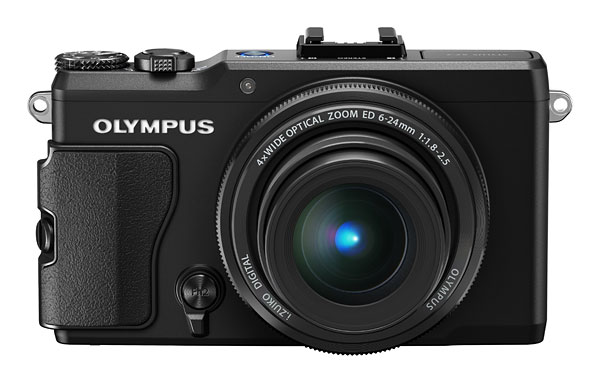
DE: Can you say anything generally about these high image quality compacts? Where do they fit into your plans?
TT: Personally, I'm really surprised recently that many manufacturers are going that direction.
MH: Yeah, yeah. That's right.
DE: Really? Especially given that Nikon just announced three cameras with one-inch sensors.
TT: Sure. That was really a surprise for us. Of course, we see that there is a market for cameras like this, for example the DSLR users who would like to have a more compact, pocket camera, but they'd like to keep the high image quality; that kind of situation...
DE: Yeah. So you understand that, but you're surprised that there are so many models crowding into the field.
TT: Yeah, sure. Very crowded, yeah
MH: Exactly. And also product differentiation concerns us, because at the end of the day, somehow, we need to focus on something Olympus-like or areas where we are able to show "Ah! Olympus is different." Right?
DE: Ahh...
MH: If we go into that segment, so many players are there, and our strength would be something like a smaller size, the design of the camera compared to rivals. But it's very difficult to characterize us as unique [on size alone].
DE: You can't differentiate yourself. It's hard, because...

MH: Well, I mean Sony's product is good. Sensors are very much their strength, so that's very difficult to use to differentiate us.
DE: Yeah.
MH: So it's better for Olympus going for a camera like the PEN-F; very classic, and different from others, right?
DE: Mmm.
MH: You need to think about how you are able to differentiate yourself. That's right.
DE: Focus on products like the PEN-F that are really unique, and where Olympus is very different.
MH: That's right.
DE: Yes, I understand.

DE:I'm curious about the Olympus AIR. I saw that here last year, and I was personally very excited by it. I'm kind of a hacker geek, you know. I have a 3D printer and stuff that I have never have time to use. But my sense is that the AIR hasn't really caught on; there aren't really hackers building things around it. On the other hand, when I was here at the time, I learned about Olympus' very significant business making optical systems for industry, and that you expected to see some activity around the AIR in that part of the business. How has the AIR worked out overall? And I guess this is maybe a question for Hana-san: You talked about core businesses. Is optical subsystems still a core business that's part of imaging?
MH: Yes. I mean, the broader point of view is that this is a very unique product, that appeals to two segments. One is B2C, consumers, and the other is B2B, business use. And you need to develop business areas on the B2B side, because so many opportunities are available. In the meantime our consumer business [for the AIR] has become little bit stagnant, right? But this one has two meanings for B2C side, the consumer side, and there is kind of the product now being offered to various industry people. It can be used like this, can be used like that. Something like a test phase.
DE: So two very, very different markets, and the consumer side is a little stagnant. In general, it seems like some of these cellphone accessory cameras haven't really caught on.
TT: Sure.
DE: But then on the business-to-business side, there you're in a trial phase. There it's a much longer cycle, because people have to evaluate, and then they have to design into their systems. But strategically, over the long-term, you see that being a solid business?
MH: Yes.
TT: That kind of the investigation is still going on with the Olympus AIR.
DE: Yeah. And so those evaluations are happening currently.
TT: Yeah.
DE: Actually, on the AIR it occurred to me that it may just be that it's a matter return on investment for the advertising, but we've seen very little focus on the consumer side of the product, at least in the US. But you know, when I shot with it myself, I enjoyed it so much; it was really, really fun and it was so different than using a regular camera. I like taking candid pictures of people, but I'm not a street photographer. I'm not very good at coming up and, you know, taking a picture with a camera in someone's face.
TT: <laughter>
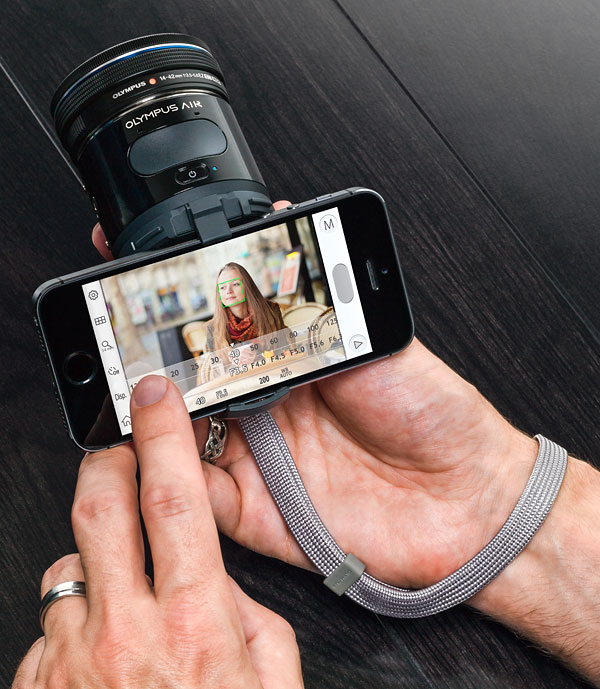
DE: But I had so much fun with the AIR! You know, I could sort of just stand there with the AIR and lens down by my side, just looking at my phone over here, without giving myself away. It was also great just to be able to get very different perspectives than I could with a camera.
MH, TT: Yeah, yeah, yeah.
DE: I could hold it up, or I could hold it way out over a railing, or something... So it seems to me like there's a lot of potential there for it, with existing Micro Four Thirds owners, but it's maybe a matter of awarenes. I don't know, could there be some ways to bundle it, you know, offer packages where you buy it with a lens, or with another camera kit?
MH: We're not ready yet, because we are watching the situation at Sony, and their marketing of their QX-series lens-style cameras. But it's not...
DE: They haven't marketed that -- at least in the US, that hasn't been marketed at all.
MH: They tried in Japan and that did not work very well.
DE: Ah!
MH: So we are not ready to make investment in the awareness or marketing. We don't focus on normal photographic users. These are not the target users of this product, as a consumer. We're targeting it just at creators, or high-creatives...
DE: The hackers, those kind of people...
TT: Yeah, sure. That kind of target users, we are setting for the AIR.
DE: Yeah, I guess my comment -- or just my observation -- was that I had so much fun with it. I think at least in the US, maybe, that there is a market for photographic users, but it's an awareness problem, and I guess as you said, it may not be worth the amount of investment for the return, it may not balance out.
MH: Yeah.
TT: That's right.
MH: We discussed [the AIR] with US retailers, and we talked about a $399 product, but they said "No, no, no, no. It should be $199 product!"
TT: <laughter>
MH: But always US retailers when we talked about sales and marketing, said "Oh, no, no, no", then they talked about $199.
DE: $199, really? Interesting, yeah. I was thinking it was already a steal; I mean, it seems like an incredible bargain at $299, so...
MH, TT: <laughter>
MH: So then if we talk about the mass business, if we go to the key, major retailers and then they talk about lower price-points then it doesn't work, you know?
DE: Yeah. It doesn't work; you can't, you can't afford to make it for that price. Very interesting!
MH: It doesn't work. Yeah.
TT: That's right.
DE: That's interesting, it's very interesting.
DE: Moving on, of course there are always questions about 4K video. When I interviewed Ogawa-san in October 2013, I asked him about 4K video and he said that basically, at that time, Olympus didn't feel that 4K was ready. There weren't enough output devices, infrastructure, etc, and so Olympus would concentrate on still image quality more so than on adding 4K. But that was a long time ago now. How does 4K fit in your current thinking about products?
TT: Yeah, compared to those days, I think the situation is changing a little bit. 4K has become more popular now.
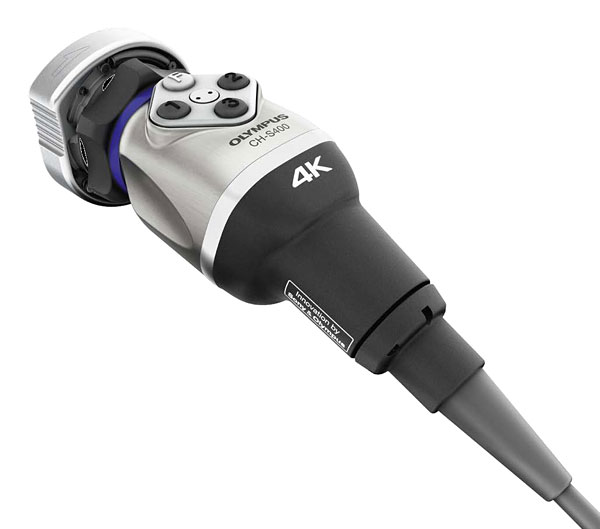
DE: Yeah. I think it's like it's becoming a checkbox, you know for customers to look for, whether or not they actually intend to use it.
TT: Yeah, sure. Sure.
DE: People will say, you know, "Oh, I have to get 4K." Even if they may not use it, people feel like they have to have it.
MH: Yeah, yeah.
TT: Yeah. Now, here, we think we agree on the situation, and yeah, in the future we will also have these kind of features, I think.
MH: To come! To come. <grins>
DE: So it's here, it's definitely part of your product plans now, yes.
TT: But for this present product, for this Olympus PEN-F, this is more... We wanted to concentrate to the photographic users. That's the reason it still doesn't have 4K.
DE: No 4K, yeah. And you're already at a very premium pricepoint, and so to try to add even more, you know, that...
TT: Mmm, sure. A very funny question we keep hearing from journalists is "Why you are using this movie-style backside LCD?"
DE: They ask, why you're using the tilt-swivel screen, but you don't have 4K?
TT: It looks like it has movie capability.
DE: Oh, OK. It suggests this is a video device to some journalists. Interesting.
(Ed. note: This was surprising to me. Apparently journalists covering more general consumer-electronic products associate a tilt-swivel screen that flips out to the side with video cameras.)
TT: But our actual intention [for the screen articulation] is very interesting. We like to use the PEN-F like this, [demonstrates with the LCD closed facing inwards, making it look more like a] film camera...
DE: Oh, so the reason was that you wanted to have that smooth back, with the leather texture like a film camera.
TT: Sure. Sure. That's the reason there is kind of a [leather-like material] on it.
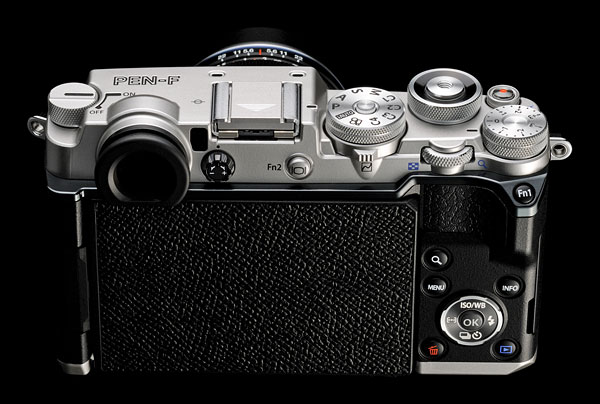
DE: Ah, that's interesting. I like tilt/swivel monitors very much. I think they're very convenient, more so than just the tilt-only.
TT: On our old camera, if you open the box [for the first time], it always comes like this. [demonstrates the camera with the screen rotated so the LCD is facing out]
DE: Oh, it always came with the LCD facing out.
TT: But not for this camera.
DE: In the box, there's the LCD...
TT: Like this.
DE: ...facing in. So really, the whole point of the tilt/swivel monitor was to be able to hide the LCD and make it look like a film camera. That is, we didn't mean it just for protection.
DE: It's not just protection. It's also for aesthetics.
TT: We're asking the user to please utilize it like this. [with the LCD screen hidden] That's our message to the user.
DE: Hah! That's very interesting. I never stopped to think about how it comes out of the box; whether it comes out with the LCD out, or the LCD in.
TT: <laughter> Yes, sure.
DE: Ah, very interesting. It's interesting to me too that the journalists -- I guess maybe more consumer electronics journalists -- they see a fold-out monitor and they immediately think video. That wouldn't have occurred to me personally, but I'm not a video guy.
DE: Another question about lens development. You guys keep coming out with more lenses, but I look at Micro Four Thirds, and one of the huge strengths of the platform is that between you and Panasonic, there are a lot of very good lenses available now. And you announced that incredible 300mm at CES, which we've played with.
TT: Mmm-hmm.
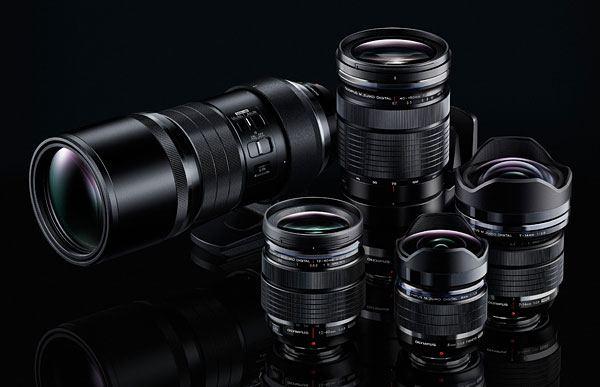
DE: I have some more questions about that down below. And now Panasonic just announced their 100-400mm zoom, so I'm curious -- again, you can't talk about product plans, but where do you think the Micro Four Thirds lens lineup needs more attention? What's your general focus going forward now?
TT: Yeah, sure. If [we look at our] Zuiko lineup...
DE: The higher-quality, the higher-end lenses, yeah.
TT: Yeah, sure. But now we have three major f/2.8 zoom lenses, very bright, [and with just] three lenses...
DE: Yeah, you go very wide, medium and tele.
TT: Sure. Then now we have the 300mm lens, and the 8mm lens, but if we [look at the] pro lineup, still we are missing, for example, [more] prime lenses.
DE: Ah, more primes in the pro lineup, yeah.
TT: Sure. That's our focusing direction, still we need to fulfill the professional lineup for enthusiast and professional photographers.
DE: Yeah. So the M1 was really the camera that you felt was carrying the OM-D line into the pro world, and so you need to continue to build out lenses.
TT: Yes, sure. And also, our benefit of the Micro Four Thirds system is very compact lenses. For this reason, we are also planning very attractive small-size...
DE: Ah! Very, very compact lenses...
TT: ...with nice image quality, yes. We are always focusing [on developments in this direction].
DE: Yeah. I see, good answer. That's one of the things that's so great about Micro Four Thirds. You can have a whole kit of lenses in [the same space as] what normally would be just an SLR and maybe one lens, yeah.
TT: Sure.
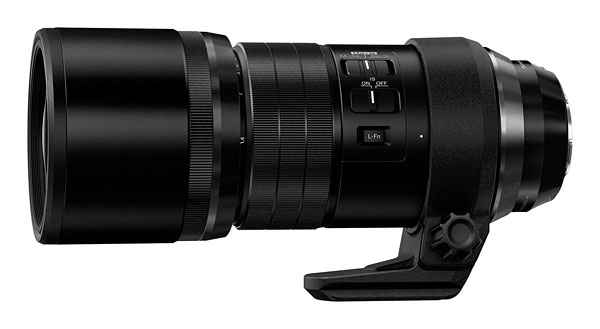
DE: I also have some questions on technology, about image stabilization. I'd mentioned the 300mm f/4...
TT: Mmm, it's amazing.
DE: I was just blown away, I could not believe it. (Ed. note: We were amazed by the 300mm f/4's IS ability when used with an E-M1 body with updated firmware.)
TT: <laughter>
DE: My lab technician was testing it, and he says "This thing's crazy!"
TT: <laughter>
DE: "We're at like 600mm-equivalent and shooting at 1/15th of a second or something..."
TT: Yeah. <laughter>
DE: In our briefings about the lens, you said "Oh, you know, six stops of IS" but we're thinking "Oh, yeah, yeah, six stops. Right..."
TT: <laughter>
DE: But it really is six stops!!
TT: Yeah, that's right. <laughter>
DE: In order to achieve that level, you had to hand-select gyroscope sensors to get low-enough noise, and they were already very high-spec parts. Was the main reason we haven't seen that level of performance before just that sensors simply weren't available that were that good, was that the main limitation?
TT: Mmm. The main reason is the difference of the gyro sensor. The sensitivity, yeah.
DE: It seems like there's just been a new generation of these gyro sensors in the last year or so, and now they are showing up in products. A key part of the 300mm's capability is that it can use both the in-lens and the in-body systems together. Were there particular challenges to combining the two systems? Or did it really just boil down to telling the IS processor that it has more range that it can shift the image over now?
TT: It's a really difficult question, but from the technology point of view, not only are the lens and body working independently, we need somehow to provide communication between the lens and the body. Also, the range of movement inside the body is limited because of the mount size.
DE: Ah, yeah; the size of the mount and just the amount of space you have in such a compact body is limited?
TT: Sure, sure. And also the size of the body, the amount of movement is huge inside of the camera.
DE: Yes, yeah.
TT: Then, since the size limitation exists in the body, the lens' IS element helps to enhance the range of the movement.
DE: Right, yeah.
TT: This is another benefit.
DE: So my question was whether there was complexity other than just telling the IS processor -- I know there's communication between the camera and the lens and everything -- but in terms of the algorithm, was it just a matter of now that the IS processor can see "Oh, now I have a much greater range; I have some range here in the lens and I have some range in the body"?
TT: Sure.
DE: Other than all the communication issues, was it as simple as that, or was there more complicated algorithms involved because it's moving two units now?
TT: I'm really sorry, I don't know actually, I am not engineer. <laughter>
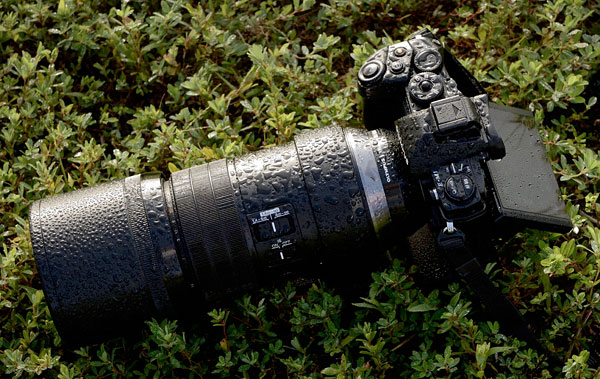
DE: <laughter> Oh, OK. I used to be an engineer too, but many, many, many years ago now; I used to be an engineer working with individual transistors. <laughter>
MH: Yeah, yeah!
TT: <laughter> Yes, sure.
DE: So the E-M1 obviously required a firmware update to be able to do the hybrid IS. Are other cameras like the original E-M5 able to be updated also like that, or are there limitations with their IS processors?
TT: There are two reasons. One is of course the technical reason. The other is also the resource problem.
DE: Mmm, the resources to be able to put that much investment into that old a camera?
TT: Yeah, that's right.
DE: So I think, first... is it just the E-M1, the E-M5 II also has it, right?
TT: Yes. And also the PEN-F, yes.
DE: And also the PEN-F, ah. So it's also kind of a going-forward thing. It seems to me to be a very interesting strategy, that the body had one generation of gyro sensor in it, and now you can put a better gyro sensor in the lens. But the new bodies like the PEN-F, are they also presumably using a gyro sensor -- maybe not hand-selected, but like the one in the 300mm? Or are they using a little bit lower level within the body?
TT: I'm not sure which class of gyro sensor this camera uses, but I guess the [stabilization system's working range] itself is the same as the E-M1, right? The E-M5 Mark II has five steps in-body.
DE: Oh, five steps in the body, so that sounds like the new generation sensor.
TT: I guess, yes, I guess same as the E-M5 Mark II or something.
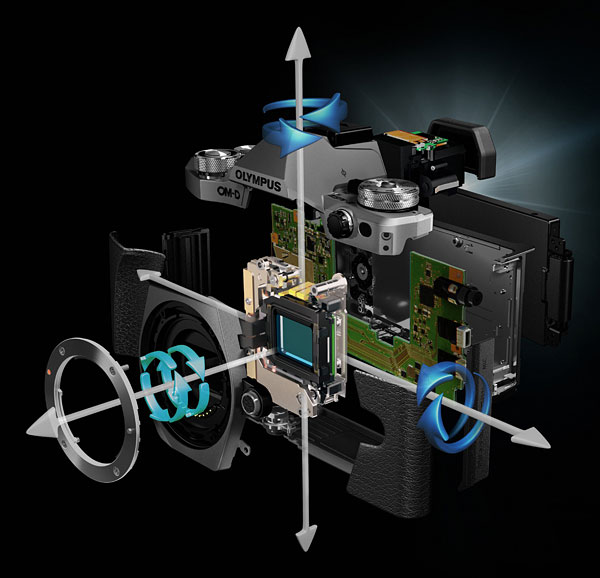
DE: Certainly, the hybrid IS is most important in a very long tele, but is that something that would become a more standard part of your lens lineup? Will we see that become standard at some point, that you have hybrid IS, or will it only be on very limited models?
TT: Yes, mainly of course for the telephoto. As I said to enhance the range of the movement, I think it's really helpful for the telephoto.
DE: Yes. And so less need for it on a wider-angle lens, because you don't have to shift the image as much.
TT: Theoretically. But if we have a more wide lens or standard range of a lens with synchronized IS, I'm not sure if we can contribute somehow a more high level of the IS, yes.
DE: Well that was my next and actually last question was... You know, six stops is just crazy.
TT: Sure.
DE: I was out shooting with it at night, and really the limitation wasn't the camera shake, it was subject movement. At a certain point, you don't need six stops a lot of the time because you have to use faster shutter speed for your subject anyway.
TT: Sure.
DE: The camera and the lens were just rock-solid, but I had so many shots that I missed because at 1/15th or 1/30th of a second, if the subject moves, it's going to blur anyway. So I'm wondering, are we maybe coming to a point where IS has gotten good enough? That more IS power won't really help you that much? It won't bring that much benefit, and so maybe now it's just a matter of the cost comes down over time, I don't know. I'm sort of curious about how you view IS over the next couple of years.
TT: I think of course, not all lenses need IS. But of course a certain range of the lenses, they'll have this system.
DE: So it sounds like it'll certainly be part of your sort of lens strategy or toolkit, and the lenses that need it like longer telephotos, we'll see it, yeah.
TT: Mmm, yeah.
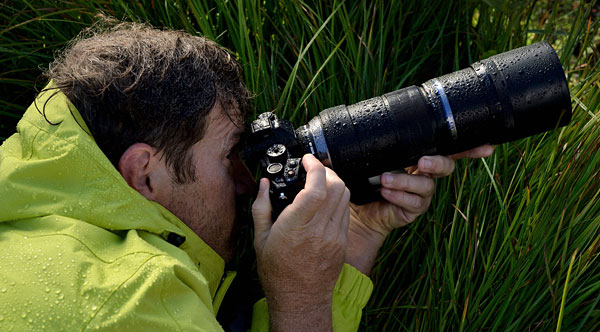
DE: After my experience shooting with the 300mm, I kind of have the feeling that most of the time, five stops is going to be as much as you would end up using. I dunno, unless perhaps you're doing low-light telephoto still-lifes or something.
TT: <laughter>
DE: I don't know, you know. <laughter> If you put a vase of flowers in a dark room a long ways away, but yeah... I was very surprised... It was just a realization to me that the subject movement actually becomes more of an issue.
TT: Once I personally used the 300mm, then felt the very stable image in the viewfinder, it's "Wow!", right? Then after that, I met one of the key guys from R&D for the technology of the IS.
DE: One of the guys who developed the IS system, yeah?
TT: And I said "Congratulations! It's very wonderful! Maybe this is kind of a big bang in the market." But he said this is not end of the story.
DE: Really?? So...
TT: <laughter> He said clearly to me that he had some higher ambitions for the IS technology. I cannot say here what type of thing that is, but he has higher ambitions to achieve.
DE: I think at some point you have IS and you let go of the camera, and it just floats there, you know? <laughter> Anti-gravity IS, maybe, or something? Yeah!
MH, TT: <laughter>
TT: I'm really excited to hear that kind of story from him.
MH: That kind of engineer is very genuine... generous. (Ed. note: "accommodating" vs "generous"?) At the first stage of the development, we set a goal of five steps of IS.
DE: Yeah.
MH: But then in the middle we decided it's not good enough, so we raised the bar up to six steps, and they figured out how they can make it. You know, they figured out the technology, then they made it.
DE: So you started developing the 300mm f/4 with a goal of five stops, but then the engineers said...
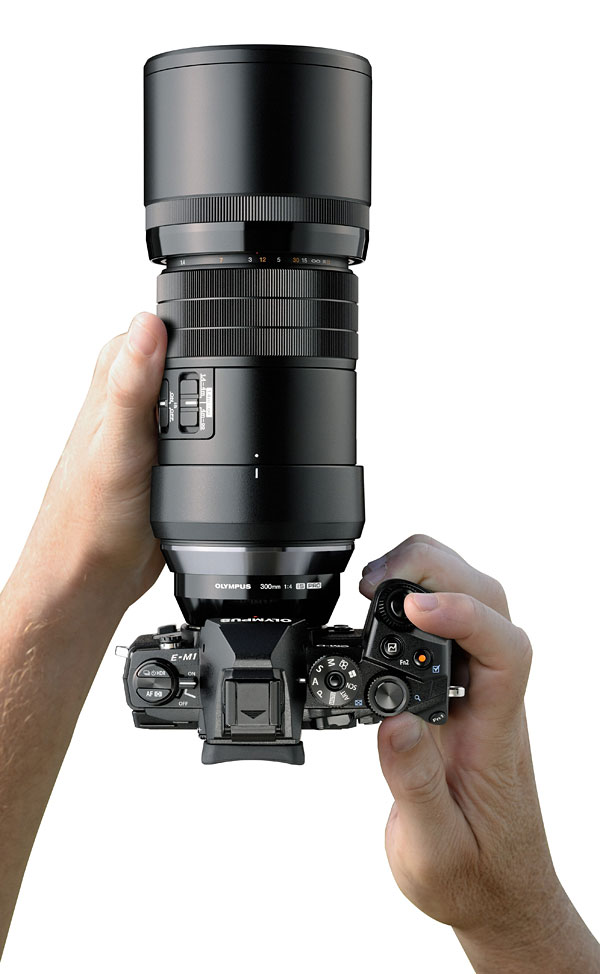
MH: "No, not enough!"
DE: Not the engineers, you... the marketing side came and said we needed six stops.
MH: Yeah.
DE: ...and so then the engineers figured out how. And now the engineers are saying now that they can go further.
MH: It's amazing.
DE: Yeah. One thing that's very challenging... You mentioned the stability of the viewfinder image, and I had a very good experience this way with the 300mm, but I have seen some IS systems it can be very hard to frame accurately, because you make a little movement and it compensates, which changes your view, then you shift to adjust to that, and it compensates again...
MH: Yeah.
TT: That's right.
DE: ...and then once you're steady, then it drifts back. So that's a very tricky balance to make it so that it's stable but you can aim it. It's like the camera has to figure out, -- the person's stopped moving, so I need to be looking here.
MH: During the course of development, we used the EE-1...
DE: Oh, the red dot sight?
MH: If we use this, then it's easier to frame. We're talking about a special device, [and using it by] looking at the viewfinder and also [the red dot sight, using both eyes]...
DE: Oh, oh!
MH: Then your second eye is looking at a broader view [to help keep track of framing].
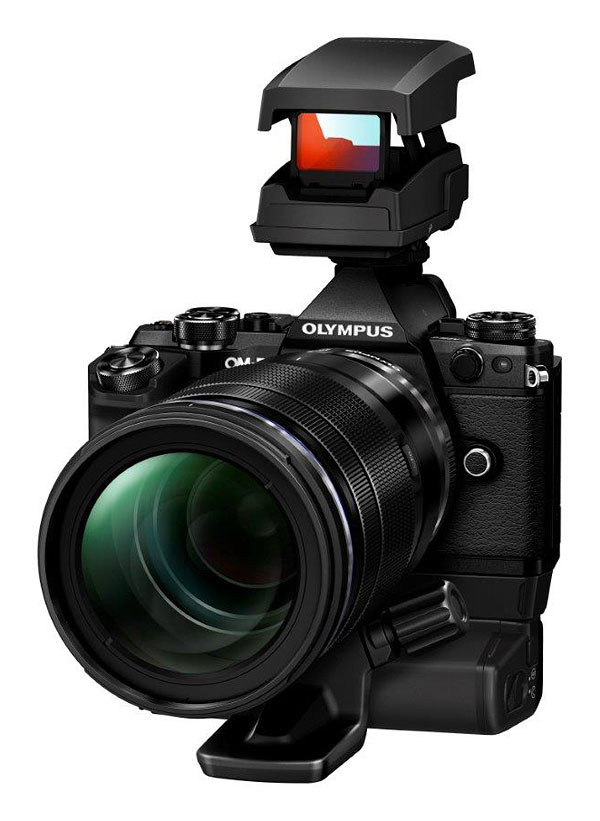
DE: Yeah. But right now the EE-1 sits on top, because it mounts in a hot shoe] Maybe if there was a bracket so you could have both [side-by-side], so one eye sees through the EVF and the other one sees the red dot sight...
MH: Then you can adjust it. They can always balance, you know.
DE: That would be... yeah, yeah!
MH: Even with a moving subject, you can follow it.
DE: Yeah, that would be very good.
MH: With only one viewfinder, you can lose the subject easily.
DE: Yes, yes.
MH: But if you can use both eyes, then you can easily follow the subject.
DE: That would be very important for viewfinder lag with moving subjects. That would be a very useful accessory. So you need like a bracket or something that you have almost like binoculars with...
MH: That's right.
DE: Ah, so I want to see that. I will expect to see that now!
MH, TT: <laughter>
MH: I tried it once, you know.
DE: Oh, I've seen the red dot sight, but you have the bracket out here now? [They indicated they did.] Oh, oh! Yes! And is that a product now, or just an engineering mockup?
TT: No, no. The bracket itself is made by a third-party.
DE: Oh, it's a third-party bracket!
DE: I'll definitely check that out. I have to run to other appointments, but I will come back this afternoon and take a picture of that. (Ed. note: Stay tuned, I'll post a brief article about this accessory; it's actually quite simple, but the combination of a red-dot sight with the live view in the EVF is very effective!)
MH: It's very effective!
DE: Can you adjust the magnification on the EE-1 sight, or is it just always 1:1?
TT: No, just the direction.
DE: Oh, you can adjust the direction to calibrate.
TT: The direction, but not the magnification.
DE: I think that's all my questions, and we're exactly on time. Thank you very much for your time! (And I'll come back to check out the EE-1 accessory.)
TT: You're welcome!